Health care systems around the globe focus on clinical outcome, user satisfaction and using the most cost-efficient solutions. With our mission to improve people’s mobility, we strive for leg and socket solutions that truly improve the service delivery to amputees. With One Visit Prosthetics we support clinics to improve their user flow with user centred care and the flexibility to adapt to fluctuations in providing care.
One Visit Prosthetics with Direct Socket is for all user types, from transtibial to transfemoral users, from K1 to K4 with a user weight limit of 166 kg, while One Visit Prosthetics with Connect TF is designed for transfemoral users with a lower activity level and a user weight limit of 125 kg.
Physiotherapy
The Physiotherapy Perspective
Finding and fitting a good prosthesis is key to improve mobility and with every new situation people need time to adjust and to get used to it, especially with Direct Socket. Having professional guidance and support from a physiotherapist is key for successful outcomes and satisfied users. Please see below more information about situations in daily life written from a physiotherapist perspective.
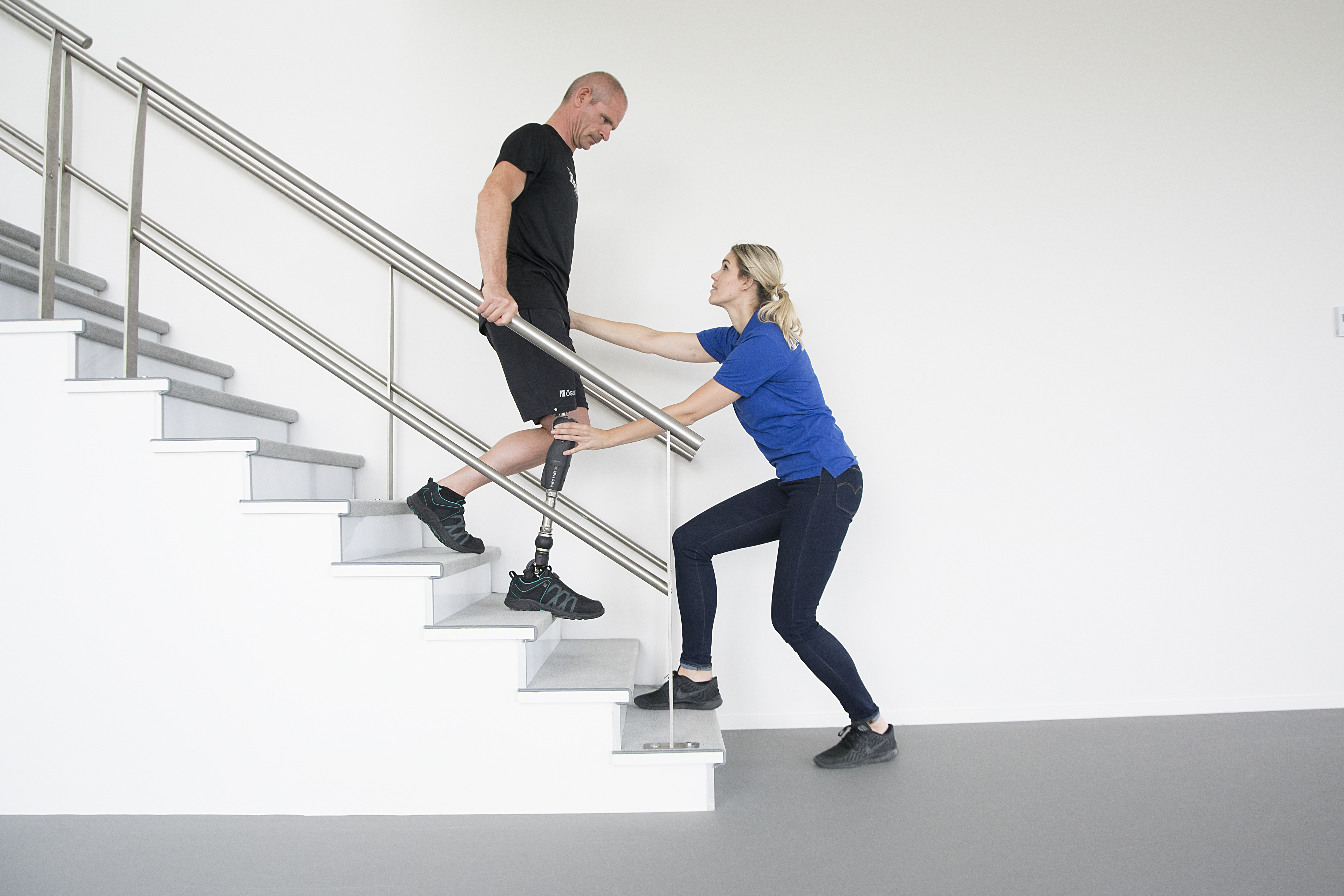
Activities of Daily Living (ADL)
There are a variety of benefits that users with a prosthesis with Direct Socket TF socket will find throughout their day. Donning the prosthetic leg is quick and simple, no time wasting to find the correct position of the socket. This allows more flexibility as the user just focuses on their preferred knee/foot position. The prosthetic leg may feel lighter compared to when used with previous sockets.
A simple pleasure such as sitting down without any discomfort or pressure at the back of their residuum, allows even weightbearing between the buttocks when sitting relaxed. The improved balance and stability whilst sat down can allow more freedom for the user to do activities in this position with their limb still donned comfortably. When the user prepares to stand up, they are ready to load both legs evenly, helping to reduce extra pressure from overloading their sound side repeatedly whenever they stand up or sit down.
When it comes to walking with their prosthesis, the user may feel less restriction from the socket edges, in addition to being able to lean forwards easily whilst sitting down/standing without the socket brim getting in the way of their hip/stomach and causing discomfort which may prevent them from completing these activities regularly.
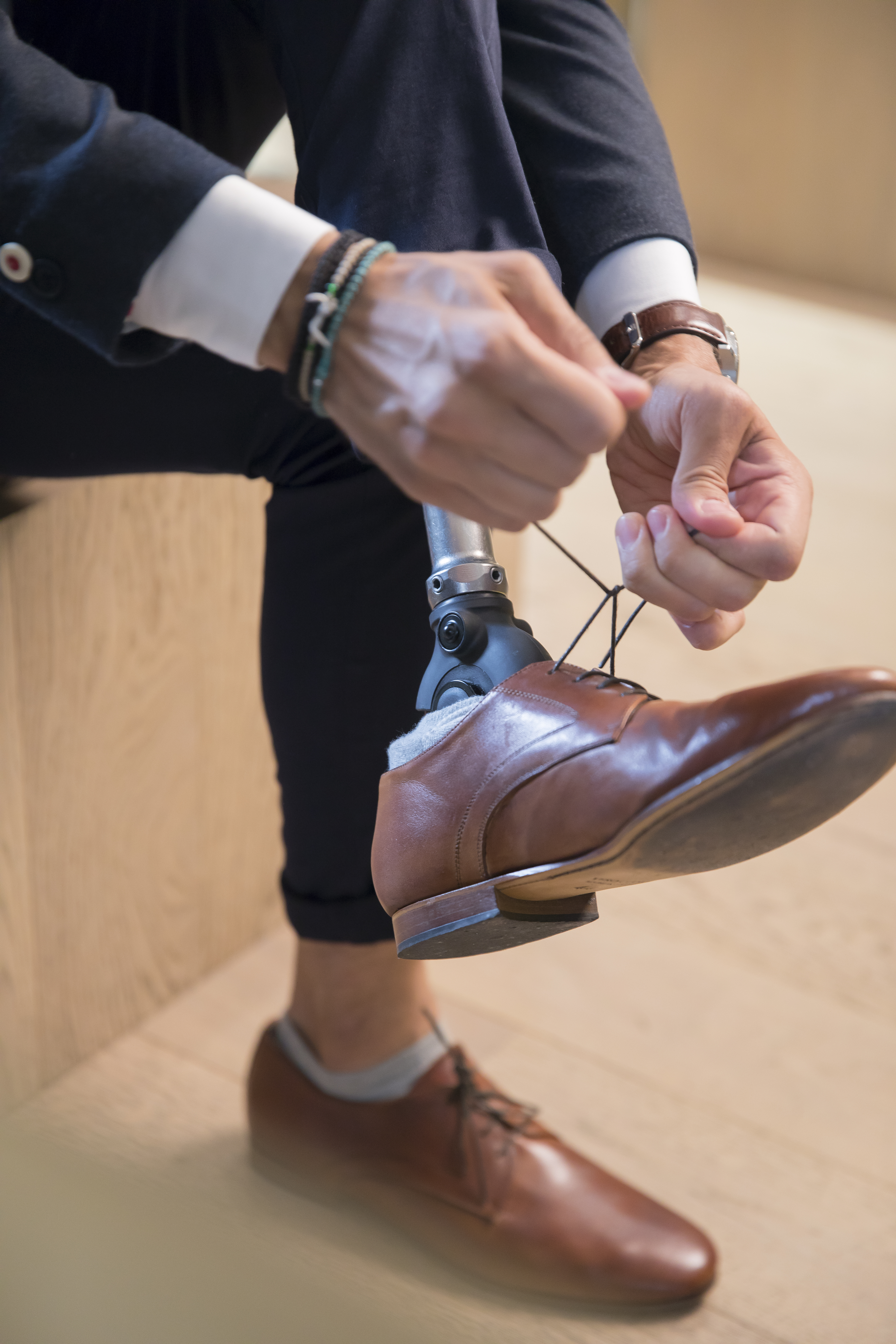
Benefits in posture for a prosthesis with Direct Socket TF
In sitting, to compensate for the usual discomfort of a socket’s hard edges digging in at the front and back, users will offload the prosthetic side to reduce pressure, this leads to one side of the trunk tightening up whilst the other side lengthens, or they slouch backwards and sit in a posterior tilt, allowing the important postural muscles to disengage. Over prolonged periods of time, both solutions to discomfort, can cause muscle imbalances and lead to weakness, as well as changing a user’s perception of their midline awareness, which is seen as compensations in gait such as dropping a shoulder/flexing the trunk.
With a direct socket, there are no hard edges causing discomfort, which allows for even weightbearing between the buttocks. This allows the pelvis to be in a level position which can have a beneficial impact on a user’s posture over time. By allowing the users pelvis to remain level in sitting, we can reinforce this position sub-consciously to have better carry over from what is worked on with the therapists during gait re-education and exercises.
In traditional sockets, users feel they need to rest onto the back of the socket whilst walking, and subsequently don’t activate the same muscles as you would without a prosthesis. When walking with a direct socket, there is more freedom for movement, as key movements around the pelvis are less restricted, and encourage the user to activate more muscles to allow a smooth, more symmetrical gait. For example, opening up more movement of the pelvis going forwards, naturally encouraged the trunk to rotate and the opposite arm to swing to promote balance.
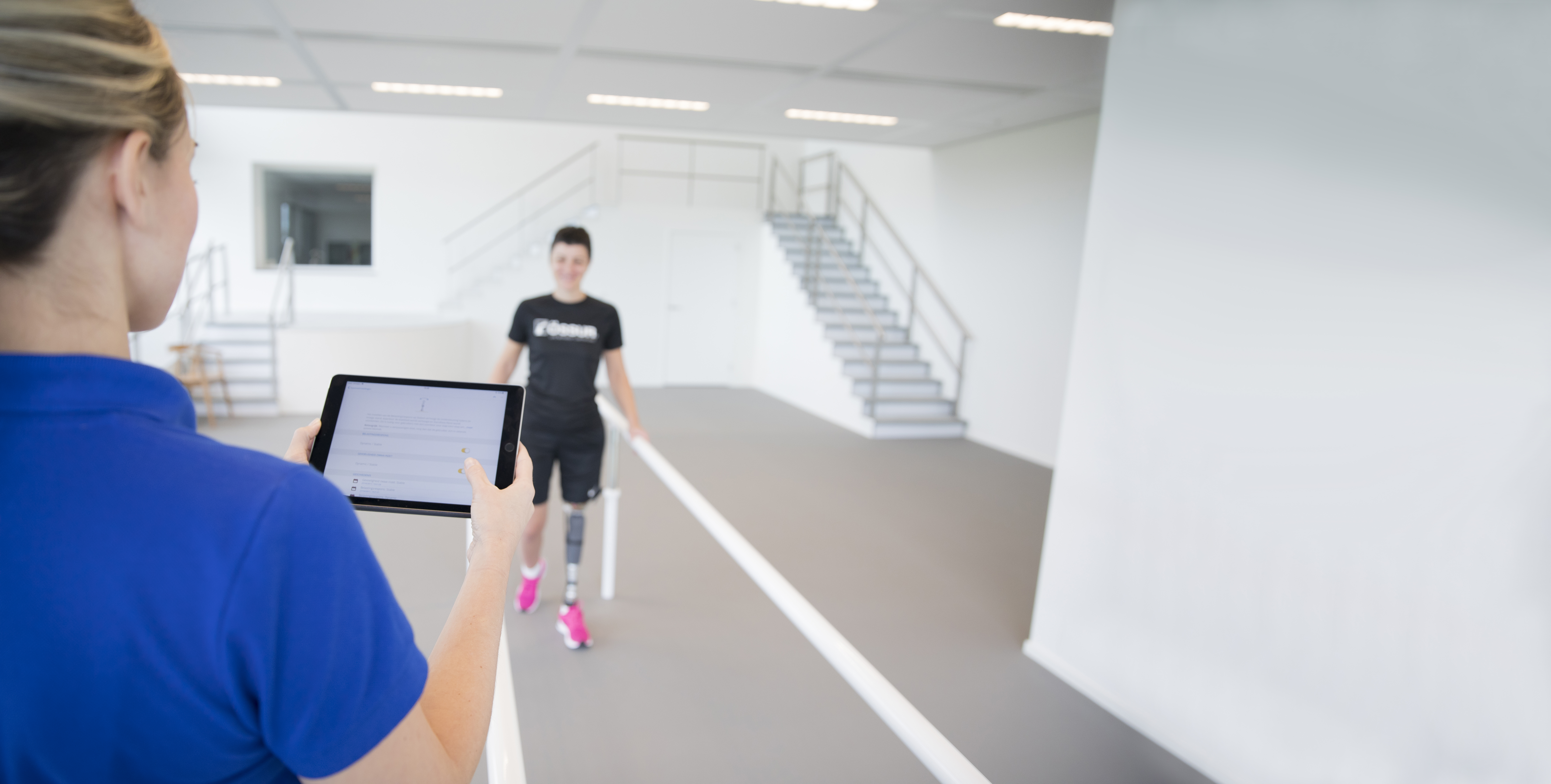
The first experience after the first fitting with a prosthesis with Direct Socket TF
The manufacturing process is a more relaxed experience for users. They can lie down, and be supported with pillows, feel relaxed and maintain energy. Likely to get a truer fit of user’s anatomy in this relaxed state, when not tensing fatiguing muscles trying to remain upright on one leg for the process. It means that users are not left alone for long periods of time whilst the CPO is in the workshop, as the joint sessions with the Physiotherapist ensures that time and resources can be utilised effectively. For example, exercises/assessments or information can be done/provided by the Physiotherapist whilst waiting for the socket to return for user to begin gait training with physio. The whole process allows for working with the user, and not just the product. More cohesive approach, involves the user much more, buying into the process, happier outcome.
Once the socket has been finished and returned to the user, it is quick and simple to don the limb. No need to worry about precisely where the back of the socket sits, just focus on the knee/foot position as user prefers. This might reduce the time spent on learning how to don the limb.
In the days and weeks following fitting of the socket, users often need adjustments to trimlines of the socket as their volume fluctuates (possibly with increased activity). Often this leads to time wasted during physiotherapy sessions waiting for the CPO’s to attend and fix the issue. With the direct socket, there is no adjusting needed after the first fitting of the socket. This allows users to progress with their physiotherapy training straight away without interruptions from the socket.
Whilst learning to walk with a “traditional” socket, there is always discomfort to begin with, lots of small adjustments are often needed particularly as the user becomes more active and their residuum reduces in volume/changes shape. With the Direct socket, there is no need to get used to feeling of pressure under the sitting bones in the buttocks, or discomfort from a hard brim sticking into the groin area, with its flexible outer brim the DSTF removes this sensation. Of course there will be an adaption time to the overall pressure and a need for working with the muscles which where for a long time inactive.
First feeling/experience of the user is the “freedom” of movement. There is much more leg mobility, sitting in the chair and reaching out for a drink, overall sitting comfort and picking an object from the floor are the first described experiences. It also might be perceived as unsecure/ unstable since the muscles where for a long time not used or since the trochanter wall is free could be perceived as.
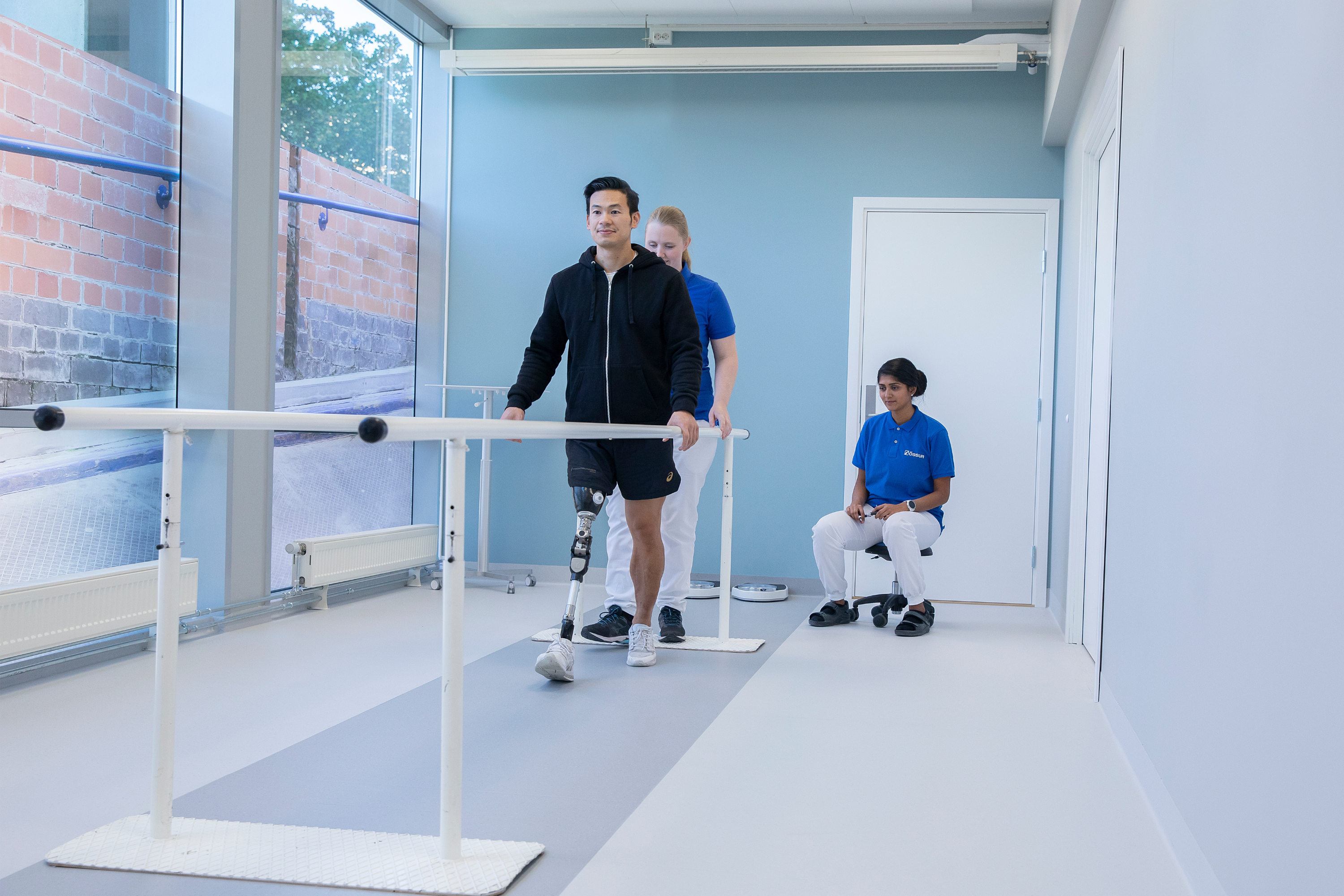
User confidence with a prosthesis with Direct Socket TF
Once fitted with a DSTF, physiotherapy training focuses on educating and training the user how to control using the muscles in their residual limb. New users of the DSTF will feel as if the socket is less stable because of the lower brim and lack of high sides, and that they are not “sitting” on the socket which support “the lazy” walker. This is experienced by the user as different, maybe difficult in the beginning. It takes more muscles and stability control of the residual limb. Normally, we don’t think about how we walk, this “lack of support” is different for the user, like when they first started learning to walk with a prosthesis following their amputation. The key thing is about engaging the muscles and not relying on external supports.
We don’t train users to walk any differently whilst using a “traditional socket method” when they first become an amputee. The difference is that the DSTF socket allows the user more freedom to utilise the muscles they should be using to walk with. It takes time and practice to feel confident with this freedom, as well as to learn and trust what their body can do without this support. Therefore is a period of adjustment necessary to transition between a traditional socket and a DSTF? This time depends on the user capabilities.

(Specific) Exercises with a prosthesis with Direct Socket TF
Here are some exercises to utilise muscles in the residual limb to get used to wearing a DSTF:
- Standing balance; left right shift
- Sitting down and standing up whilst loading the prosthesis.
- Bouncing exercise; more freedom anterior.
- Step forward and step backwards (with/without exercise step).
- Pelvic tilts in sitting/ standing.
- Split stance, prosthetic limb behind, practicing pelvic rotation forwards, reaching the point where the knee starts to flex.
- During your physiotherapy training your physiotherapist may focus on gait re-education. This will likely involve create a longer stance phase and assessing and emphasizing the movements of pelvic rotation/ trunk rotation. They may use resisted gait to help you to feel the right movement. The therapist will resist your shoulders or your pelvis to encourage you to move into these positions. This can be using hands/resistance bands and can be reproduced at home with assistance.
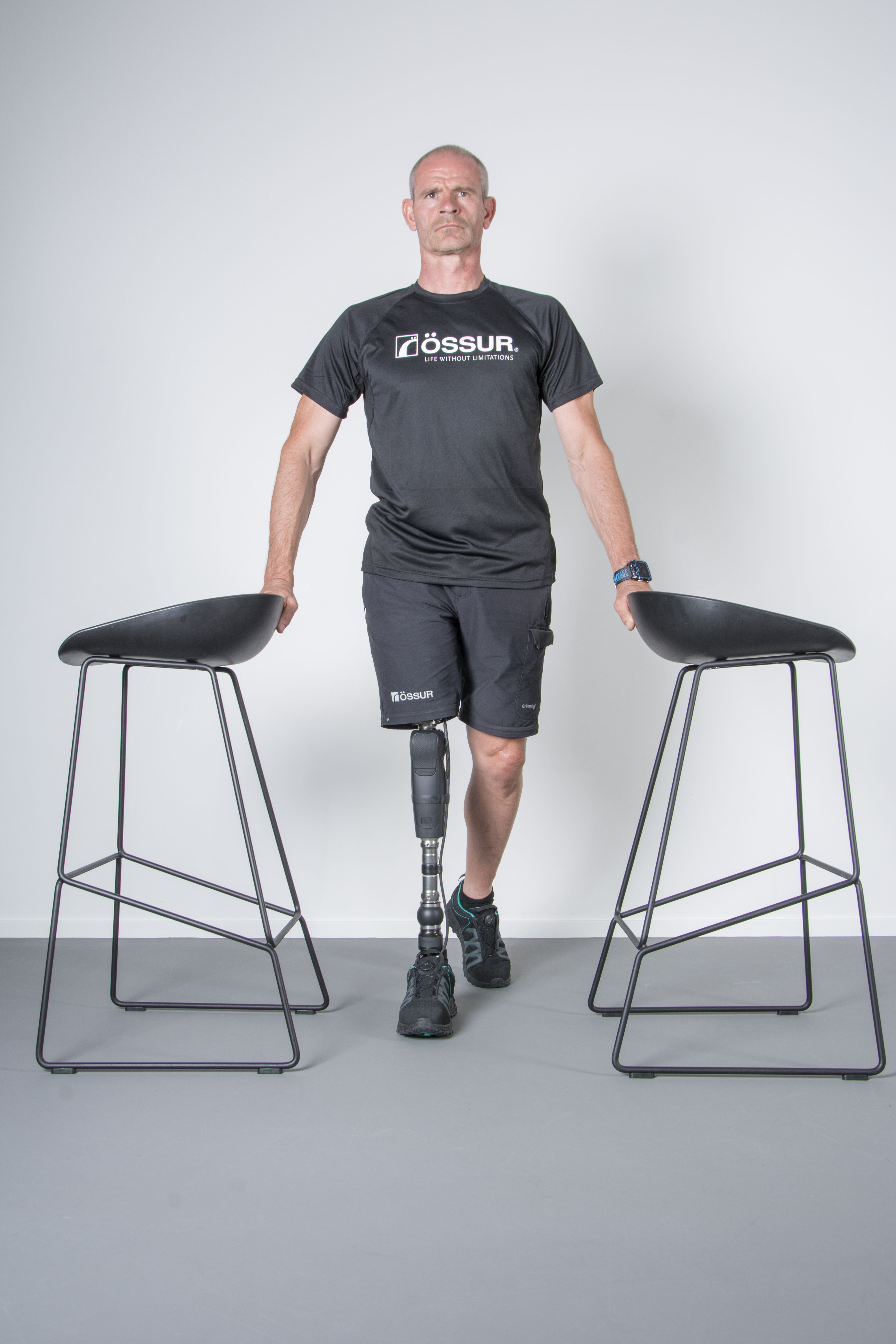
The Value of Being Well Prepared
A very important aspect of One Visit Prosthetics is the preparation before an appointment with the user. As the fitting and manufacturing process takes place around the user, the clinic room needs to be prepared with all the appropriate tools and equipment. Below we talk about the different elements and the different approach with Direct Socket TT, Direct Socket TF and Connect TF.
The Clinic Room
Part of the implementation of One Visit Prosthetics at clinics is the clinic room assessment. Users spend most of the time in this space and we believe it needs to be in a clean, well organised and comfortable environment. Users only have to sit or lay down during the fitting process and therefore it is important to have a comfortable height adjustable chair or bench. Next is to have all required equipment and materials close to the workspace. Direct Socket and Connect TF requires some special tools and equipment in combination with the tools and equipment that are present in every clinic room by default.
Direct Socket Tool Kit (for Direct Socket TT)
The Direct Socket Tool Kit includes all the required tools to manufacture the socket. Direct Socket Tool Kit provides the prosthetist with the tools to consistently make a reliable and well-fitting socket using the Direct Socket system.
Iceross Direct Casting Liner (for Direct Socket)
The Iceross Direct Casting Liner has been specially designed for direct lamination. The profile accommodates to a standard 3mm Iceross liner.
Direct Socket Material Kit (for Direct Socket TT/TF)
The Material Kit includes all materials to make one Direct Socket. The material kit is offered with 4”, 5”, 7” and 9” braids. The 7” and 9” braids are also available with a large distal connector.
Össur Brim
Direct Socket TF is designed for transfemoral users and the Össur Brim is designed to accommodate with the special needs for transfemoral users. The Brim is available in different sizes. The separately ordered Össur Brim is a flexible proximal silicone brim that is available in 13 sizes.
Connect TF Socket
The Connect TF adjustable socket is available in 4 different sizes: Medium Short, Medium Standard, Large Short and Large Standard and is available for both the right or left side. It is also possible to change the side. Connect TF should be used together with the Össur Iceross Transfemoral Locking liner.
Screwdriver Kit with Minimal setting options (for Connect TF)
The Bobbin Screwdriver Kit with minimal torque settings is required to adjust the tension of the shells by changing the setting of the wires.
Building the Prosthesis
The screening before the One Visit appointment is important to understand the needs of the user and to order the appropriate components prior to the appointment. Finalise the build of the prosthesis with a selection from our comprehensive range of products, suitable for K1 to K4 users.
Innovate Service Delivery for Transtibial & Transfemoral Amputees
Ready to innovate your service delivery with One Visit Prosthetics? Or do you just want to learn more and talk to one of the specialists from our prosthetic team? Please contact us or download more information on One Visit Prosthetic with Direct Socket TT, Direct Socket TF or Connect TF
Contact our Prosthetic Team who will be able to answer any queries.
Send in your questions and we will collate them and put them to our ambassadors.
Join our Facebook Community to connect with like-minded people and share stories and experiences.
Contact our Prosthetic Team who will be able to answer any queries.